Immunization Strategies: Case Studies and Public Health Management
VerifiedAdded on 2023/03/23
|7
|1665
|51
Homework Assignment
AI Summary
This assignment delves into various immunization and vaccination scenarios, addressing public health considerations and management strategies. It begins with a case involving a 62-year-old male needing a tetanus vaccination, detailing assessment, vaccination recommendations, and the immune response. It further discusses the MMR vaccine for a postnatal patient, addressing concerns related to blood transfusions. The assignment also tackles vaccine hesitancy, providing advice on addressing misinformation. Pertussis is examined, with recommendations for immunization and antibiotic therapy, including considerations for pregnant women. Additional points cover measles prevention through MMR vaccination, the importance of annual influenza vaccines, and appropriate immunization schedules for infants and children. Specific vaccines and dosages are recommended based on age and health history, aligning with public health guidelines and aiming to prevent infectious diseases.
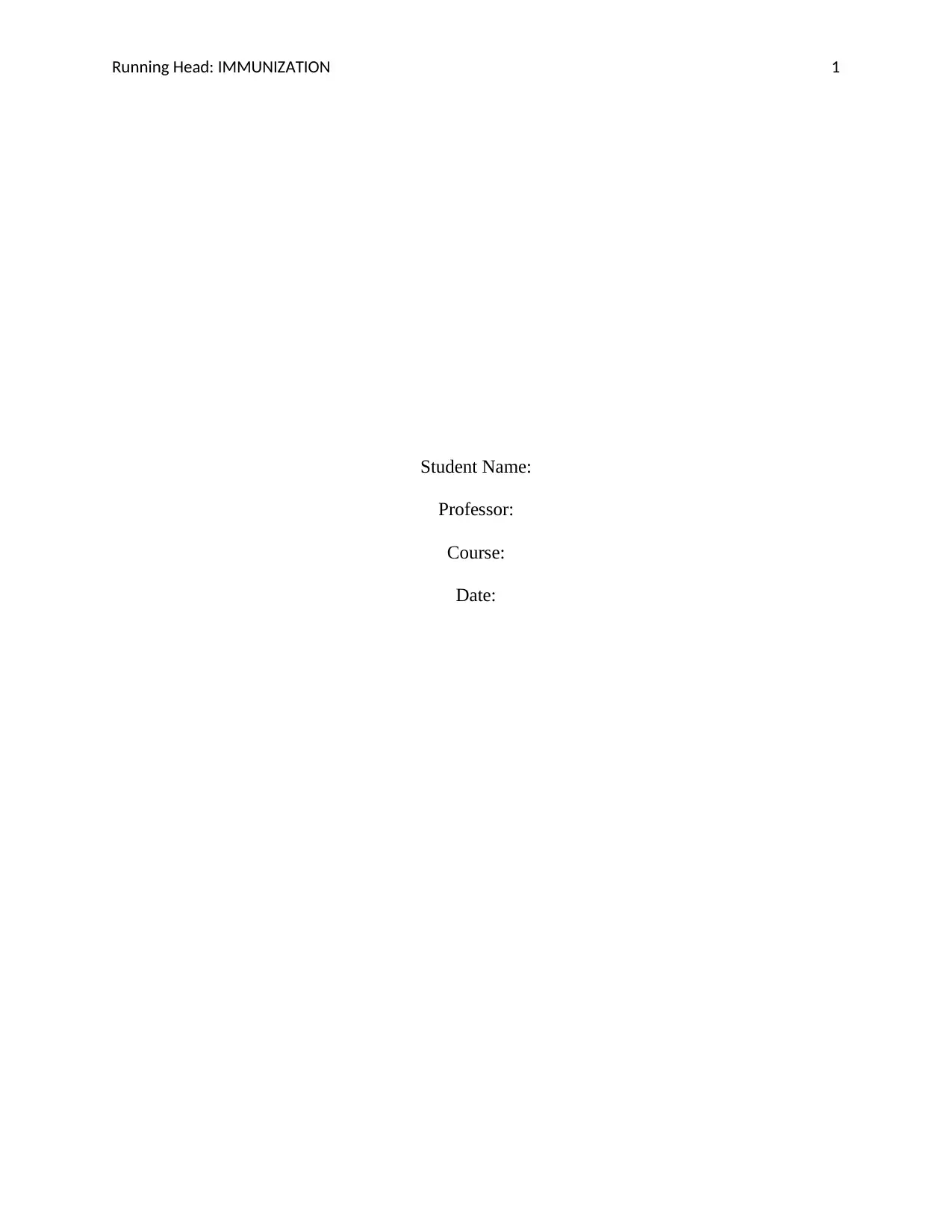
Running Head: IMMUNIZATION 1
Student Name:
Professor:
Course:
Date:
Student Name:
Professor:
Course:
Date:
Paraphrase This Document
Need a fresh take? Get an instant paraphrase of this document with our AI Paraphraser
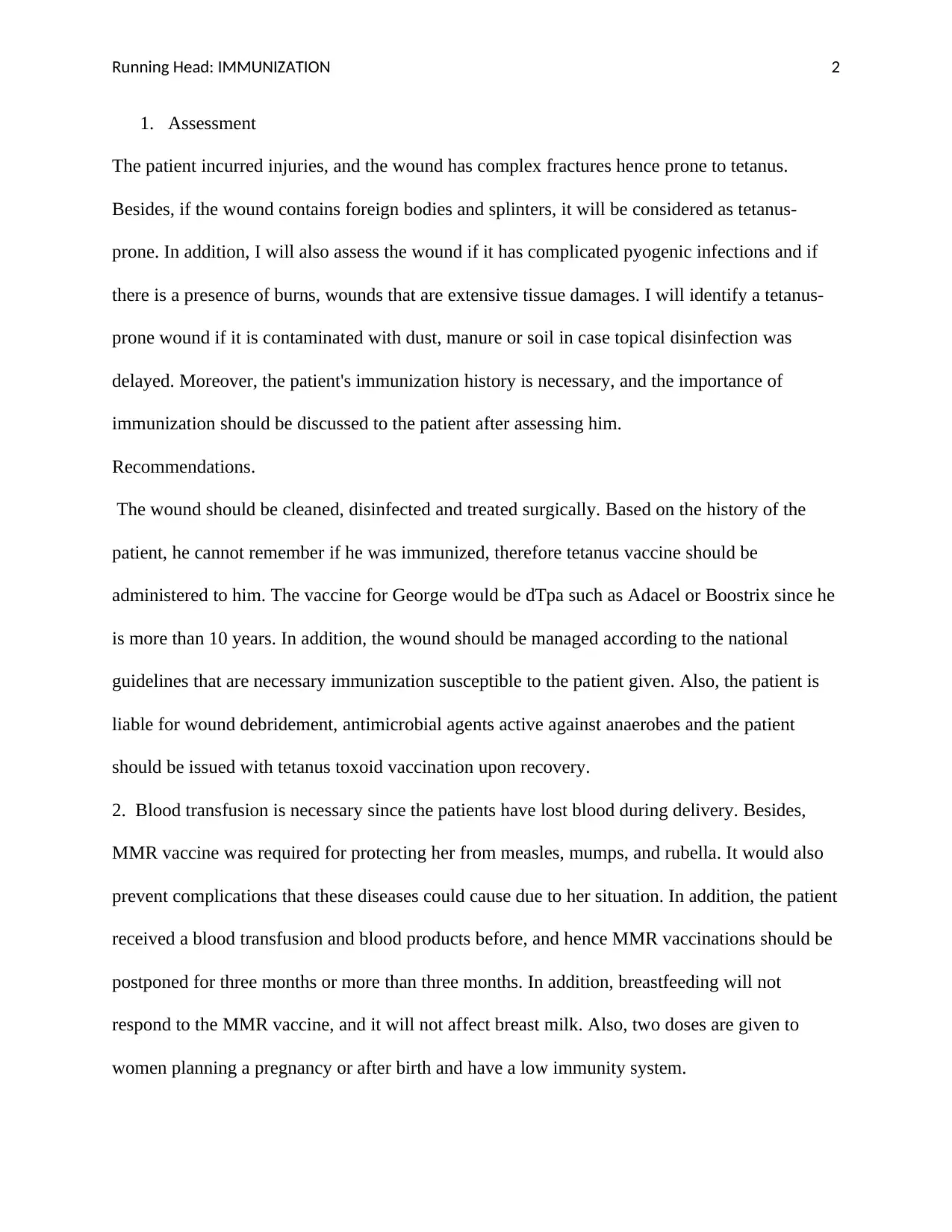
Running Head: IMMUNIZATION 2
1. Assessment
The patient incurred injuries, and the wound has complex fractures hence prone to tetanus.
Besides, if the wound contains foreign bodies and splinters, it will be considered as tetanus-
prone. In addition, I will also assess the wound if it has complicated pyogenic infections and if
there is a presence of burns, wounds that are extensive tissue damages. I will identify a tetanus-
prone wound if it is contaminated with dust, manure or soil in case topical disinfection was
delayed. Moreover, the patient's immunization history is necessary, and the importance of
immunization should be discussed to the patient after assessing him.
Recommendations.
The wound should be cleaned, disinfected and treated surgically. Based on the history of the
patient, he cannot remember if he was immunized, therefore tetanus vaccine should be
administered to him. The vaccine for George would be dTpa such as Adacel or Boostrix since he
is more than 10 years. In addition, the wound should be managed according to the national
guidelines that are necessary immunization susceptible to the patient given. Also, the patient is
liable for wound debridement, antimicrobial agents active against anaerobes and the patient
should be issued with tetanus toxoid vaccination upon recovery.
2. Blood transfusion is necessary since the patients have lost blood during delivery. Besides,
MMR vaccine was required for protecting her from measles, mumps, and rubella. It would also
prevent complications that these diseases could cause due to her situation. In addition, the patient
received a blood transfusion and blood products before, and hence MMR vaccinations should be
postponed for three months or more than three months. In addition, breastfeeding will not
respond to the MMR vaccine, and it will not affect breast milk. Also, two doses are given to
women planning a pregnancy or after birth and have a low immunity system.
1. Assessment
The patient incurred injuries, and the wound has complex fractures hence prone to tetanus.
Besides, if the wound contains foreign bodies and splinters, it will be considered as tetanus-
prone. In addition, I will also assess the wound if it has complicated pyogenic infections and if
there is a presence of burns, wounds that are extensive tissue damages. I will identify a tetanus-
prone wound if it is contaminated with dust, manure or soil in case topical disinfection was
delayed. Moreover, the patient's immunization history is necessary, and the importance of
immunization should be discussed to the patient after assessing him.
Recommendations.
The wound should be cleaned, disinfected and treated surgically. Based on the history of the
patient, he cannot remember if he was immunized, therefore tetanus vaccine should be
administered to him. The vaccine for George would be dTpa such as Adacel or Boostrix since he
is more than 10 years. In addition, the wound should be managed according to the national
guidelines that are necessary immunization susceptible to the patient given. Also, the patient is
liable for wound debridement, antimicrobial agents active against anaerobes and the patient
should be issued with tetanus toxoid vaccination upon recovery.
2. Blood transfusion is necessary since the patients have lost blood during delivery. Besides,
MMR vaccine was required for protecting her from measles, mumps, and rubella. It would also
prevent complications that these diseases could cause due to her situation. In addition, the patient
received a blood transfusion and blood products before, and hence MMR vaccinations should be
postponed for three months or more than three months. In addition, breastfeeding will not
respond to the MMR vaccine, and it will not affect breast milk. Also, two doses are given to
women planning a pregnancy or after birth and have a low immunity system.
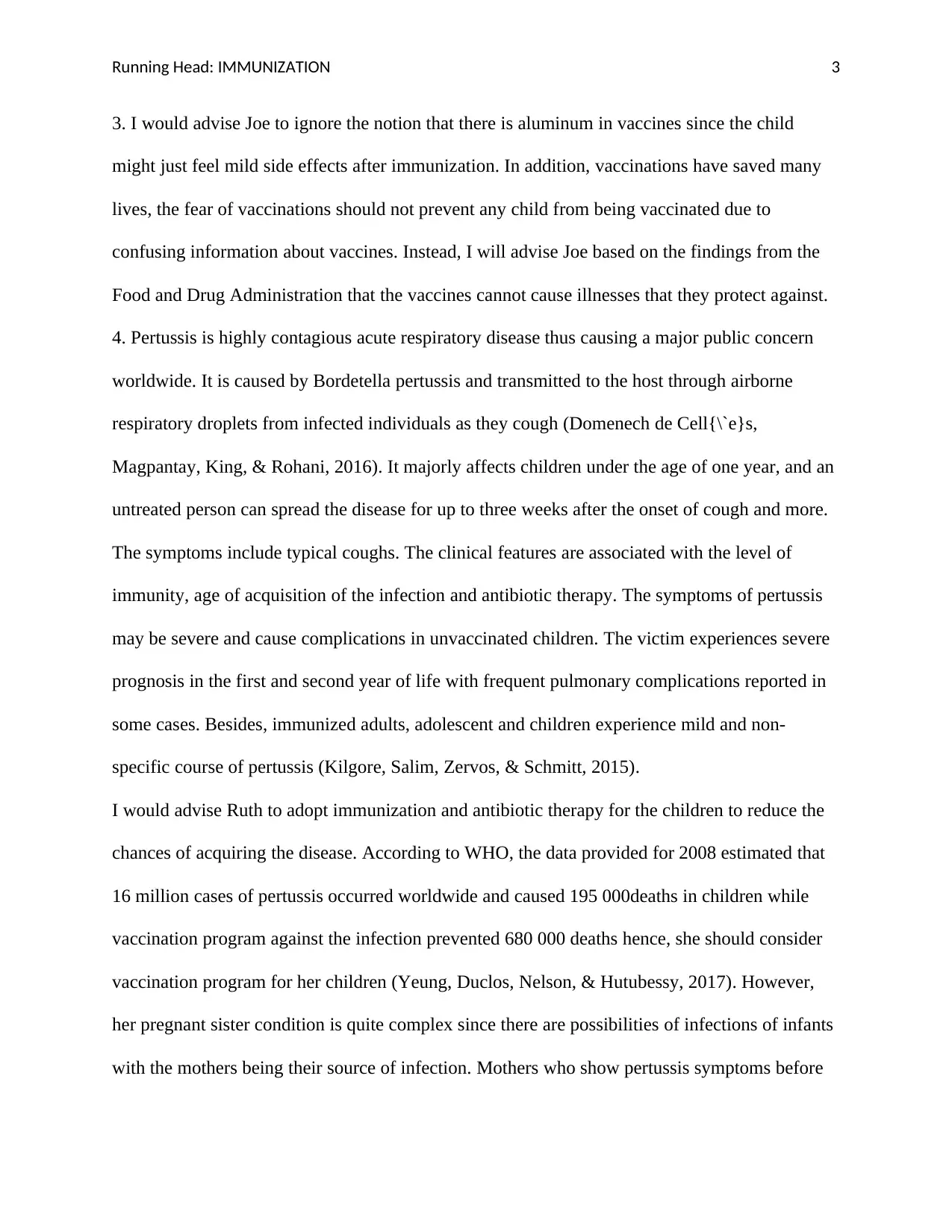
Running Head: IMMUNIZATION 3
3. I would advise Joe to ignore the notion that there is aluminum in vaccines since the child
might just feel mild side effects after immunization. In addition, vaccinations have saved many
lives, the fear of vaccinations should not prevent any child from being vaccinated due to
confusing information about vaccines. Instead, I will advise Joe based on the findings from the
Food and Drug Administration that the vaccines cannot cause illnesses that they protect against.
4. Pertussis is highly contagious acute respiratory disease thus causing a major public concern
worldwide. It is caused by Bordetella pertussis and transmitted to the host through airborne
respiratory droplets from infected individuals as they cough (Domenech de Cell{\`e}s,
Magpantay, King, & Rohani, 2016). It majorly affects children under the age of one year, and an
untreated person can spread the disease for up to three weeks after the onset of cough and more.
The symptoms include typical coughs. The clinical features are associated with the level of
immunity, age of acquisition of the infection and antibiotic therapy. The symptoms of pertussis
may be severe and cause complications in unvaccinated children. The victim experiences severe
prognosis in the first and second year of life with frequent pulmonary complications reported in
some cases. Besides, immunized adults, adolescent and children experience mild and non-
specific course of pertussis (Kilgore, Salim, Zervos, & Schmitt, 2015).
I would advise Ruth to adopt immunization and antibiotic therapy for the children to reduce the
chances of acquiring the disease. According to WHO, the data provided for 2008 estimated that
16 million cases of pertussis occurred worldwide and caused 195 000deaths in children while
vaccination program against the infection prevented 680 000 deaths hence, she should consider
vaccination program for her children (Yeung, Duclos, Nelson, & Hutubessy, 2017). However,
her pregnant sister condition is quite complex since there are possibilities of infections of infants
with the mothers being their source of infection. Mothers who show pertussis symptoms before
3. I would advise Joe to ignore the notion that there is aluminum in vaccines since the child
might just feel mild side effects after immunization. In addition, vaccinations have saved many
lives, the fear of vaccinations should not prevent any child from being vaccinated due to
confusing information about vaccines. Instead, I will advise Joe based on the findings from the
Food and Drug Administration that the vaccines cannot cause illnesses that they protect against.
4. Pertussis is highly contagious acute respiratory disease thus causing a major public concern
worldwide. It is caused by Bordetella pertussis and transmitted to the host through airborne
respiratory droplets from infected individuals as they cough (Domenech de Cell{\`e}s,
Magpantay, King, & Rohani, 2016). It majorly affects children under the age of one year, and an
untreated person can spread the disease for up to three weeks after the onset of cough and more.
The symptoms include typical coughs. The clinical features are associated with the level of
immunity, age of acquisition of the infection and antibiotic therapy. The symptoms of pertussis
may be severe and cause complications in unvaccinated children. The victim experiences severe
prognosis in the first and second year of life with frequent pulmonary complications reported in
some cases. Besides, immunized adults, adolescent and children experience mild and non-
specific course of pertussis (Kilgore, Salim, Zervos, & Schmitt, 2015).
I would advise Ruth to adopt immunization and antibiotic therapy for the children to reduce the
chances of acquiring the disease. According to WHO, the data provided for 2008 estimated that
16 million cases of pertussis occurred worldwide and caused 195 000deaths in children while
vaccination program against the infection prevented 680 000 deaths hence, she should consider
vaccination program for her children (Yeung, Duclos, Nelson, & Hutubessy, 2017). However,
her pregnant sister condition is quite complex since there are possibilities of infections of infants
with the mothers being their source of infection. Mothers who show pertussis symptoms before
⊘ This is a preview!⊘
Do you want full access?
Subscribe today to unlock all pages.

Trusted by 1+ million students worldwide
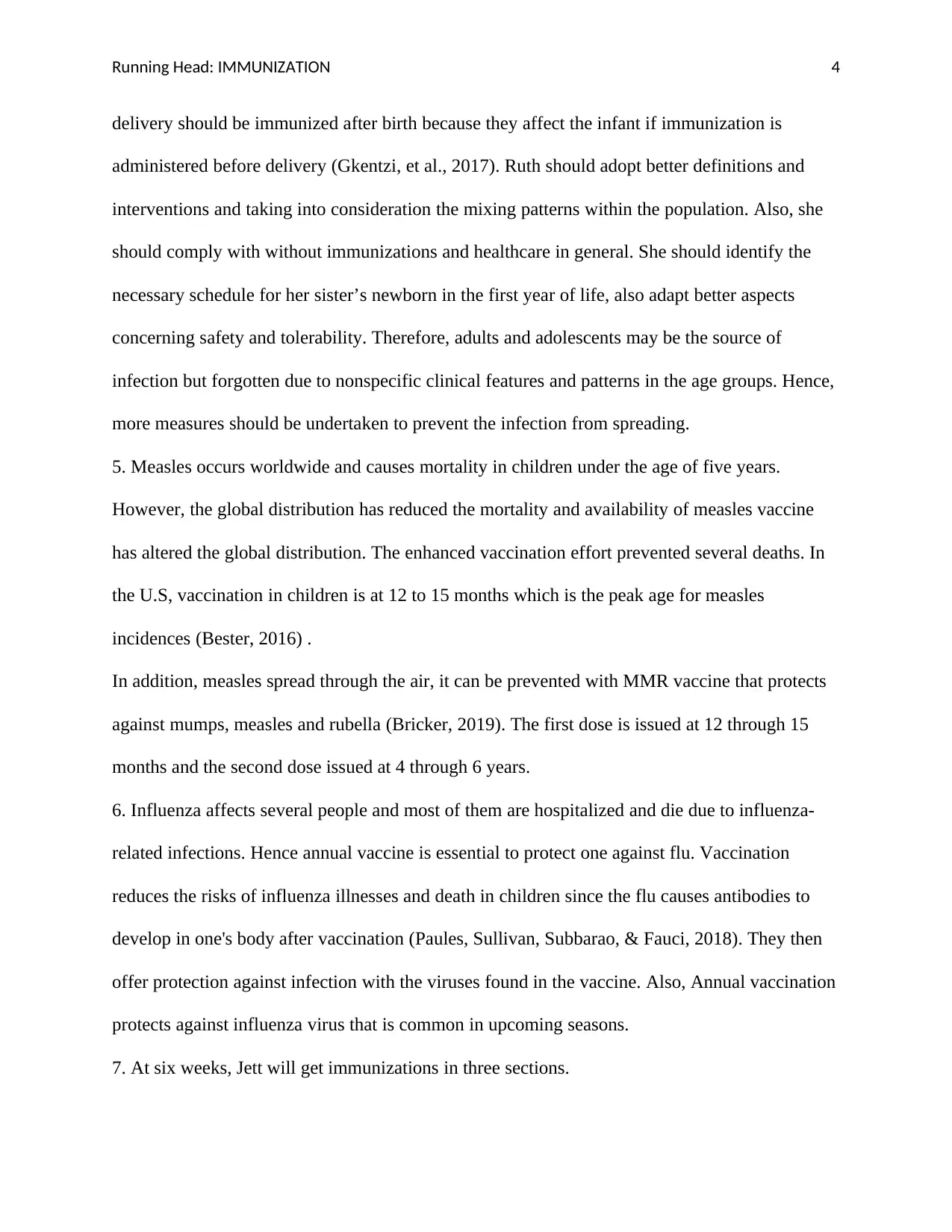
Running Head: IMMUNIZATION 4
delivery should be immunized after birth because they affect the infant if immunization is
administered before delivery (Gkentzi, et al., 2017). Ruth should adopt better definitions and
interventions and taking into consideration the mixing patterns within the population. Also, she
should comply with without immunizations and healthcare in general. She should identify the
necessary schedule for her sister’s newborn in the first year of life, also adapt better aspects
concerning safety and tolerability. Therefore, adults and adolescents may be the source of
infection but forgotten due to nonspecific clinical features and patterns in the age groups. Hence,
more measures should be undertaken to prevent the infection from spreading.
5. Measles occurs worldwide and causes mortality in children under the age of five years.
However, the global distribution has reduced the mortality and availability of measles vaccine
has altered the global distribution. The enhanced vaccination effort prevented several deaths. In
the U.S, vaccination in children is at 12 to 15 months which is the peak age for measles
incidences (Bester, 2016) .
In addition, measles spread through the air, it can be prevented with MMR vaccine that protects
against mumps, measles and rubella (Bricker, 2019). The first dose is issued at 12 through 15
months and the second dose issued at 4 through 6 years.
6. Influenza affects several people and most of them are hospitalized and die due to influenza-
related infections. Hence annual vaccine is essential to protect one against flu. Vaccination
reduces the risks of influenza illnesses and death in children since the flu causes antibodies to
develop in one's body after vaccination (Paules, Sullivan, Subbarao, & Fauci, 2018). They then
offer protection against infection with the viruses found in the vaccine. Also, Annual vaccination
protects against influenza virus that is common in upcoming seasons.
7. At six weeks, Jett will get immunizations in three sections.
delivery should be immunized after birth because they affect the infant if immunization is
administered before delivery (Gkentzi, et al., 2017). Ruth should adopt better definitions and
interventions and taking into consideration the mixing patterns within the population. Also, she
should comply with without immunizations and healthcare in general. She should identify the
necessary schedule for her sister’s newborn in the first year of life, also adapt better aspects
concerning safety and tolerability. Therefore, adults and adolescents may be the source of
infection but forgotten due to nonspecific clinical features and patterns in the age groups. Hence,
more measures should be undertaken to prevent the infection from spreading.
5. Measles occurs worldwide and causes mortality in children under the age of five years.
However, the global distribution has reduced the mortality and availability of measles vaccine
has altered the global distribution. The enhanced vaccination effort prevented several deaths. In
the U.S, vaccination in children is at 12 to 15 months which is the peak age for measles
incidences (Bester, 2016) .
In addition, measles spread through the air, it can be prevented with MMR vaccine that protects
against mumps, measles and rubella (Bricker, 2019). The first dose is issued at 12 through 15
months and the second dose issued at 4 through 6 years.
6. Influenza affects several people and most of them are hospitalized and die due to influenza-
related infections. Hence annual vaccine is essential to protect one against flu. Vaccination
reduces the risks of influenza illnesses and death in children since the flu causes antibodies to
develop in one's body after vaccination (Paules, Sullivan, Subbarao, & Fauci, 2018). They then
offer protection against infection with the viruses found in the vaccine. Also, Annual vaccination
protects against influenza virus that is common in upcoming seasons.
7. At six weeks, Jett will get immunizations in three sections.
Paraphrase This Document
Need a fresh take? Get an instant paraphrase of this document with our AI Paraphraser
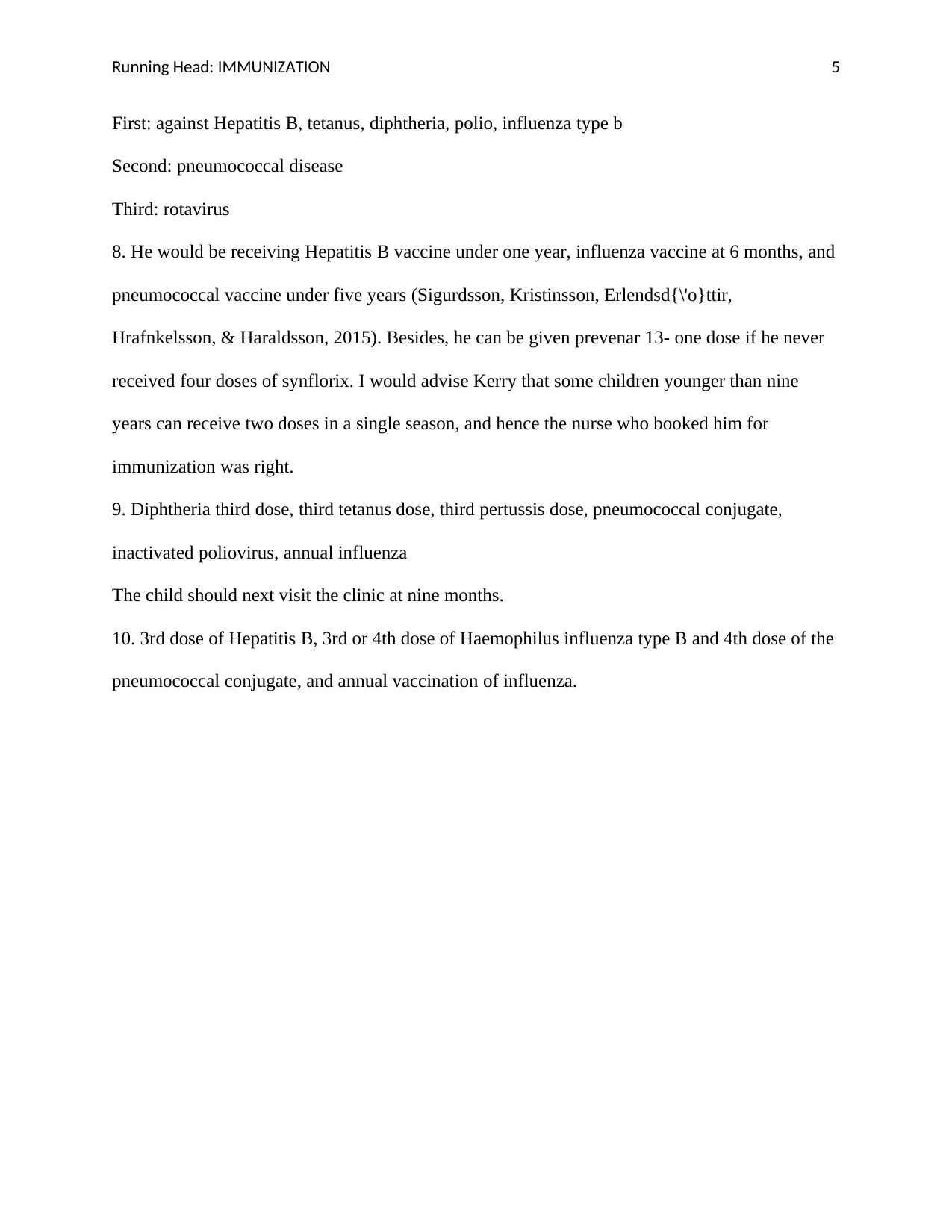
Running Head: IMMUNIZATION 5
First: against Hepatitis B, tetanus, diphtheria, polio, influenza type b
Second: pneumococcal disease
Third: rotavirus
8. He would be receiving Hepatitis B vaccine under one year, influenza vaccine at 6 months, and
pneumococcal vaccine under five years (Sigurdsson, Kristinsson, Erlendsd{\'o}ttir,
Hrafnkelsson, & Haraldsson, 2015). Besides, he can be given prevenar 13- one dose if he never
received four doses of synflorix. I would advise Kerry that some children younger than nine
years can receive two doses in a single season, and hence the nurse who booked him for
immunization was right.
9. Diphtheria third dose, third tetanus dose, third pertussis dose, pneumococcal conjugate,
inactivated poliovirus, annual influenza
The child should next visit the clinic at nine months.
10. 3rd dose of Hepatitis B, 3rd or 4th dose of Haemophilus influenza type B and 4th dose of the
pneumococcal conjugate, and annual vaccination of influenza.
First: against Hepatitis B, tetanus, diphtheria, polio, influenza type b
Second: pneumococcal disease
Third: rotavirus
8. He would be receiving Hepatitis B vaccine under one year, influenza vaccine at 6 months, and
pneumococcal vaccine under five years (Sigurdsson, Kristinsson, Erlendsd{\'o}ttir,
Hrafnkelsson, & Haraldsson, 2015). Besides, he can be given prevenar 13- one dose if he never
received four doses of synflorix. I would advise Kerry that some children younger than nine
years can receive two doses in a single season, and hence the nurse who booked him for
immunization was right.
9. Diphtheria third dose, third tetanus dose, third pertussis dose, pneumococcal conjugate,
inactivated poliovirus, annual influenza
The child should next visit the clinic at nine months.
10. 3rd dose of Hepatitis B, 3rd or 4th dose of Haemophilus influenza type B and 4th dose of the
pneumococcal conjugate, and annual vaccination of influenza.
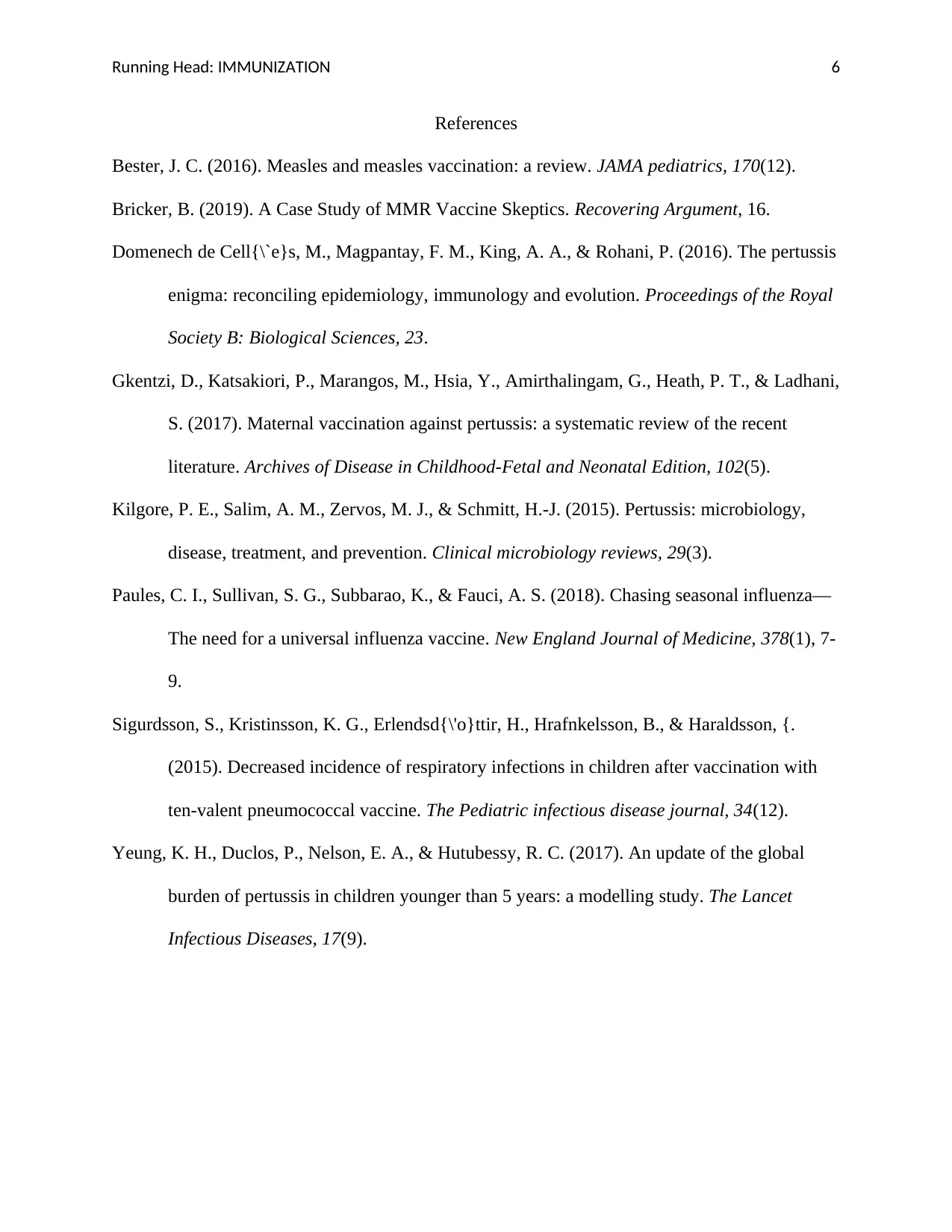
Running Head: IMMUNIZATION 6
References
Bester, J. C. (2016). Measles and measles vaccination: a review. JAMA pediatrics, 170(12).
Bricker, B. (2019). A Case Study of MMR Vaccine Skeptics. Recovering Argument, 16.
Domenech de Cell{\`e}s, M., Magpantay, F. M., King, A. A., & Rohani, P. (2016). The pertussis
enigma: reconciling epidemiology, immunology and evolution. Proceedings of the Royal
Society B: Biological Sciences, 23.
Gkentzi, D., Katsakiori, P., Marangos, M., Hsia, Y., Amirthalingam, G., Heath, P. T., & Ladhani,
S. (2017). Maternal vaccination against pertussis: a systematic review of the recent
literature. Archives of Disease in Childhood-Fetal and Neonatal Edition, 102(5).
Kilgore, P. E., Salim, A. M., Zervos, M. J., & Schmitt, H.-J. (2015). Pertussis: microbiology,
disease, treatment, and prevention. Clinical microbiology reviews, 29(3).
Paules, C. I., Sullivan, S. G., Subbarao, K., & Fauci, A. S. (2018). Chasing seasonal influenza—
The need for a universal influenza vaccine. New England Journal of Medicine, 378(1), 7-
9.
Sigurdsson, S., Kristinsson, K. G., Erlendsd{\'o}ttir, H., Hrafnkelsson, B., & Haraldsson, {.
(2015). Decreased incidence of respiratory infections in children after vaccination with
ten-valent pneumococcal vaccine. The Pediatric infectious disease journal, 34(12).
Yeung, K. H., Duclos, P., Nelson, E. A., & Hutubessy, R. C. (2017). An update of the global
burden of pertussis in children younger than 5 years: a modelling study. The Lancet
Infectious Diseases, 17(9).
References
Bester, J. C. (2016). Measles and measles vaccination: a review. JAMA pediatrics, 170(12).
Bricker, B. (2019). A Case Study of MMR Vaccine Skeptics. Recovering Argument, 16.
Domenech de Cell{\`e}s, M., Magpantay, F. M., King, A. A., & Rohani, P. (2016). The pertussis
enigma: reconciling epidemiology, immunology and evolution. Proceedings of the Royal
Society B: Biological Sciences, 23.
Gkentzi, D., Katsakiori, P., Marangos, M., Hsia, Y., Amirthalingam, G., Heath, P. T., & Ladhani,
S. (2017). Maternal vaccination against pertussis: a systematic review of the recent
literature. Archives of Disease in Childhood-Fetal and Neonatal Edition, 102(5).
Kilgore, P. E., Salim, A. M., Zervos, M. J., & Schmitt, H.-J. (2015). Pertussis: microbiology,
disease, treatment, and prevention. Clinical microbiology reviews, 29(3).
Paules, C. I., Sullivan, S. G., Subbarao, K., & Fauci, A. S. (2018). Chasing seasonal influenza—
The need for a universal influenza vaccine. New England Journal of Medicine, 378(1), 7-
9.
Sigurdsson, S., Kristinsson, K. G., Erlendsd{\'o}ttir, H., Hrafnkelsson, B., & Haraldsson, {.
(2015). Decreased incidence of respiratory infections in children after vaccination with
ten-valent pneumococcal vaccine. The Pediatric infectious disease journal, 34(12).
Yeung, K. H., Duclos, P., Nelson, E. A., & Hutubessy, R. C. (2017). An update of the global
burden of pertussis in children younger than 5 years: a modelling study. The Lancet
Infectious Diseases, 17(9).
⊘ This is a preview!⊘
Do you want full access?
Subscribe today to unlock all pages.

Trusted by 1+ million students worldwide

Running Head: IMMUNIZATION 7
1 out of 7
Related Documents
Your All-in-One AI-Powered Toolkit for Academic Success.
+13062052269
info@desklib.com
Available 24*7 on WhatsApp / Email
![[object Object]](/_next/static/media/star-bottom.7253800d.svg)
Unlock your academic potential
Copyright © 2020–2025 A2Z Services. All Rights Reserved. Developed and managed by ZUCOL.





